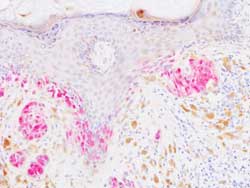Immunity drives cancer into permanent growth arrest

Fig. 1: In red, the expression of a senescence marker in former proliferating melanoma cells that underwent growth arrest. Here, senescence occurred in the context of melanoma regression induced by a natural anti-melanoma immune response. In brown, pigment bearing cells.<br>University Hospital Tübingen<br>
Scientifically this permanent growth arrest is called senescence (2, 3). As complete cancer eradication is normally not feasible, deadly metastases normally result from surviving and regrowing cancer cells. The new data now explain, how immunity and immunotherapies can efficiently control surviving cancer cells and thus protect from cancer and metastases (1, 4).
„The major goal of cancer therapy is the eradication, if possible of all cancer cells. Yet, we have learned over the past 50 years that some cancer cells survive even the most aggressive, cancer cell-killing therapy. It is assumed that such surviving cancer cell restore the cancer and cause the deadly metastases. This casts doubt on a therapeutic strategies that focus exclusively on cancer cell killing. Therefore, it was repeatedly postulated that, in addition to cancer cell killing, other (immune-) mechanisms are needed to control cancer (5, 6, 7).“ – as summarized by Professor Röcken.
The Tuebingen research team uncovered a critical, so far unknown immune mechanism that allows to permanently paralyze growing cancer cells. They showed for the first time that immune responses can cause a permanent growth arrest in cancers and also in single cancer cells (1). Scientifically this permanent growth arrest is termed senescence (2, 3).
Even under conditions where the immune system cannot kill the cancer, the two cytokines interferon (IFN) and tumor necrosis factor (TNF), may drive cancers into senescence. Thus, senescence induction causes a state, where ‚the cancer sleeps well controlled in his host’. This was first shown in an islet cancer of the pancreas (1, 4).
The same two cytokines, IFN and TNF, can drive a large number of mouse and human cancer cells into senescence. Clinically, this has two major consequences: Immune-induced senescence (figure 1) is obviously a physiological mechanism that contributes to the natural cancer control in humans (1). On the other side, recent data from cancer immune therapy suggest that the therapy is primarily efficient under conditions where the immune therapy causes permanent growth arrest of the metastases (8, 9).
Two mediators that are long known in cancer and infection immunology turn into the focus: interferon (IFN) and tumor necrosis factor (TNF). Many clinicians and researchers tried to destroy cancer and cancer-supplying vessels – like the Tuebingen researchers. Surprisingly, the Tuebingen group found that a certain combination of IFN and TNF protects mice from the development of islet cancers in the pancreas.
In the animals induction of senescence resulted in unexpectedly long protection from cancer (4). Even more important: when isolated from cancer prone animals, the ‘senescent cancer cells’ remained growth arrested without any further therapy, even when transferred into immune deficient, healthy mice. Thus, the senescent cancer cells had lost the aggressive behavior that characterizes cancer and remained well controlled (1).
This new therapeutic strategy offers the opportunity to develop new cancer immunotherapy that should be less aggressive, with relatively few side effects but highly efficient. Professor Rocken: „It is likely that in the future we will not primarily try to destroy cancer with ever more toxic regimen; instead we will focus on strategies that restore the body’s immune control over cancers “.
Media contact
Eberhard Karls University Tuebingen
Department of Dermatology
Prof. Dr. Martin Röcken
Liebermeisterstr. 25, 72076 Tuebingen
Germany
Tel. +49 (0)7071 29 84574
Fax +49 (0)7071/29 5450
E-Mail: mrocken@med.uni-tuebingen.de
Homepage: http://www.hautklinik-tuebingen.de/
References:
1. Braumüller, H, Thomas Wieder, T, Brenner, E, Aßmann, S, Hahn, M, Alkhaled, M, Schilbach, K, Essmann, F, Kneilling, M, Griessinger, C, Ranta, F, Ullrich, S, Mocikat, R, Braungart, K, Mehra, T, Fehrenbacher, B, BerdeL, J, Meier, F, van den Broek, M, Häring, HU, Handgretinger, R, Quintanilla-Martinez, L, Fend, F, Pesic, M, Bauer, J, Zender, L, Schaller, M, Schulze-Osthoff, K, Röcken, M. T-helper-1-cell cytokines drive cancer into senescence.
Nature (online 04.02.2013). doi:10.1038/nature11824.
2. Michaloglou, C. et al. BRAFE600-associated senescence-like cell cycle arrest of human naevi. Nature 436, 720-724 (2005).
3. Braig, M. et al. Oncogene-induced senescence as an initial barrier in lymphoma development. Nature 436, 660-665 (2005).
4. Müller-Hermelink, N. et al. TNFR1 signaling and IFN-gamma signaling determine whether T cells induce tumor dormancy or promote multistage carcinogenesis. Cancer Cell 13, 507-518 (2008).
5. Sporn, MB. The war on cancer. The Lancet 347, 1377-1381 (1996).
6. Gatenby, RA. A change of strategy in the war on cancer. Nature 459, 508-509 (2009).
7. Röcken, M. Early tumor dissemination, but late metastasis: insights into tumor dormancy. J. Clin. Invest. 120, 1800-1803 (2010).
8. Walter S, et al. Multipeptide immune response to cancer vaccine IMA901 after single-dose cyclophosphamide associates with longer patient survival. Nat. Med. 18, 1254–1261 (2012).
9. Brahmer JR, et al. Safety and activity of anti-PD-L1 antibody in patients with advanced cancer. N Engl J Med. 366; 2455-2465 (2012).
Media Contact
More Information:
http://www.hautklinik-tuebingen.de/All latest news from the category: Health and Medicine
This subject area encompasses research and studies in the field of human medicine.
Among the wide-ranging list of topics covered here are anesthesiology, anatomy, surgery, human genetics, hygiene and environmental medicine, internal medicine, neurology, pharmacology, physiology, urology and dental medicine.
Newest articles

Innovative 3D printed scaffolds offer new hope for bone healing
Researchers at the Institute for Bioengineering of Catalonia have developed novel 3D printed PLA-CaP scaffolds that promote blood vessel formation, ensuring better healing and regeneration of bone tissue. Bone is…

The surprising role of gut infection in Alzheimer’s disease
ASU- and Banner Alzheimer’s Institute-led study implicates link between a common virus and the disease, which travels from the gut to the brain and may be a target for antiviral…

Molecular gardening: New enzymes discovered for protein modification pruning
How deubiquitinases USP53 and USP54 cleave long polyubiquitin chains and how the former is linked to liver disease in children. Deubiquitinases (DUBs) are enzymes used by cells to trim protein…



